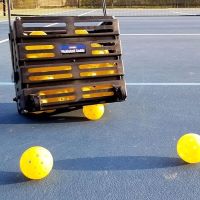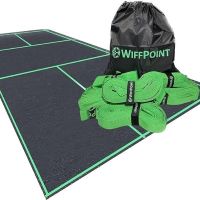Pickleball, a popular racquet sport, is known for its versatility and adaptability to different playing surfaces. While it is commonly played on hard courts, there is a growing interest in exploring other court options, including clay courts.
Clay courts, traditionally associated with tennis, offer unique playing characteristics that intrigue pickleball enthusiasts.
In this article, we will explore the feasibility of playing pickleball on clay courts, the differences between clay court surfaces, and the potential benefits and considerations for players.
Let’s delve into the exciting world of pickleball on clay courts and discover if it’s a match made in sporting heaven.

You Might Also Like:
Can You Play Pickleball on Clay Courts?
Pickleball has gained immense popularity in recent years, and players are constantly seeking new and unique venues to enjoy the game. While pickleball is traditionally played on hard courts, many enthusiasts wonder if it’s possible to play on clay courts.
In this article, we will explore the possibility of playing pickleball on clay courts and delve into the reasons why some pickleball fans prefer this surface over others. Also, Know, can you play pickleball vs paddleball on clay courts?
Why Do Pickleball Fans Like Clay Courts?
Pickleball fans like clay courts for several reasons. Firstly, clay courts provide a slower pace, allowing for longer rallies and strategic gameplay. The grip provided by the clay surface allows players to slide into shots and execute precise movements.
Additionally, clay courts are often associated with prestigious tennis tournaments and bring a sense of tradition and elegance to the game. Overall, pickleball fans appreciate the unique playing experience and the challenges that clay courts offer.
Lesser Strain
One of the primary reasons why pickleball fans enjoy playing on clay courts is the reduced strain on the body. The softer surface of clay absorbs impact better than hard courts, resulting in less stress on the joints and muscles.
This can be particularly beneficial for players who have joint issues or are prone to injuries. Playing on clay can offer a more forgiving and comfortable experience, allowing players to enjoy the game for longer periods without excessive fatigue.
Helps Longer Rallies
Clay courts tend to slow down the ball and increase its bounce, making it easier to sustain longer rallies. The slower pace of the game on clay allows players to showcase their skills, engage in strategic shot placement, and rely on precise footwork.
This aspect of clay court play is especially appreciated by pickleball fans who enjoy the tactical aspects of the game and value the opportunity to engage in extended rallies.
Lower Costs of Courts
Another advantage of clay courts is their affordability compared to traditional hard courts. Constructing and maintaining clay courts can be more cost-effective, making them an attractive option for pickleball enthusiasts and recreational players.
This affordability factor can contribute to the accessibility of the sport and encourage more people to participate in pickleball on clay courts.
While playing pickleball on clay courts is not as widespread as on hard courts, the popularity of this alternative surface is gradually increasing. It offers a unique playing experience with its distinctive characteristics and can be a refreshing change for players looking to explore different playing environments.
Pros and Cons of Har-Tru Courts vs Red Clay Courts
Here is a table comparing the pros and cons of Har-Tru courts and Red Clay courts for pickleball:
| Features | Har-Tru Courts | Red Clay Courts |
|---|---|---|
| Surface Material | Crushed stone | Crushed brick or shale |
| Appearance | Greenish color | Reddish color |
| Speed | Slightly faster | Slower pace |
| Grip | Offers a good grip | Provides more grip |
| Ball Bounce | Provides a more consistent bounce | Ball tends to bounce higher |
| Sliding Ability | Allows some sliding but is less pronounced | Easier for players to slide into shots |
| Maintenance | Less maintenance required | More maintenance required |
| Aesthetics | The reddish color adds visual appeal | The ball tends to bounce higher |
| Ball Responsiveness | The ball may not have as much bounce as on other surfaces | The higher bounce on red clay courts can affect shot execution |
Please note that the information provided in the table is a summary of the pros and cons, and individual experiences may vary based on specific court conditions and player preferences.

Har-Tru Courts:
Pros:
- Speed: Har-Tru courts offer a slightly faster pace, allowing for quicker gameplay and faster ball exchanges.
- Consistent Bounce: These courts provide a more predictable and reliable ball bounce, enabling players to anticipate and respond effectively.
- Grip: Despite the faster speed, Har-Tru courts still offer a good level of grip, allowing players to maintain control over their shots.
- Aesthetics: The greenish color of Har-Tru courts adds visual appeal to the playing surface, creating an attractive environment for pickleball.
Cons:
- Limited Sliding: While players can still slide to a certain extent, the sliding ability on Har-Tru courts is less pronounced compared to red clay courts.
- Ball Responsiveness: The ball may not have as much bounce as on other surfaces, which can require adjustments in shot selection and timing.
Red Clay Courts:
Pros:
- Sliding Ability: Red clay courts provide excellent sliding ability, allowing players to slide into shots and enhance their movement on the court.
- Grip: The texture of red clay courts offers a good grip, helping players maintain control and execute shots with precision.
- Unique Playing Experience: The slower pace and higher ball bounce on red clay courts create a distinct playing experience, requiring players to adapt their strategies.
- Visual Appeal: The reddish color of red clay courts adds a visually striking element to the court, enhancing the overall aesthetics.
Cons:
- Maintenance: Red clay courts require more maintenance, including regular watering and grooming, to ensure optimal playing conditions.
- Slower Pace: The slower speed of red clay courts may not suit players who prefer a faster and more dynamic style of play.
- Ball Response: The higher bounce on red clay courts can affect the timing and execution of shots, requiring players to adjust their gameplay accordingly.
Also Read About: pickleball vs squash, and can I play pickleball with a torn meniscus?
FAQs
Red clay courts are made from crushed brick or shale and have a reddish color, while Har-Tru courts are made from crushed stone and have a greenish color. Red clay courts tend to be slower with more grip, while Har-Tru courts are slightly faster and offer a more consistent bounce.
Pickleball played on clay courts can be slower compared to other surfaces, especially on red clay courts. The slower pace allows for longer rallies and can require different strategies and shot execution.
Clay courts used for pickleball may require regular brushing to maintain an even playing surface. It is also important to remove any debris or loose material from the court to ensure safe and enjoyable gameplay.
While playing pickleball on clay courts, players should be mindful of the surface’s grip and potential for sliding. It is important to adjust footwork and be cautious to prevent any slips or falls. Additionally, players should follow general safety guidelines such as wearing proper footwear and maintaining good sportsmanship to ensure a safe playing environment.
Final Thoughts
In conclusion, playing pickleball on clay courts is indeed possible and can bring a range of benefits for players. The softer surface reduces strain on the body, longer rallies can be sustained, and the lower costs of clay court construction make it an appealing choice for pickleball enthusiasts.
If you have the opportunity, give pickleball on clay courts a try and discover a new dimension to your favorite sport.






